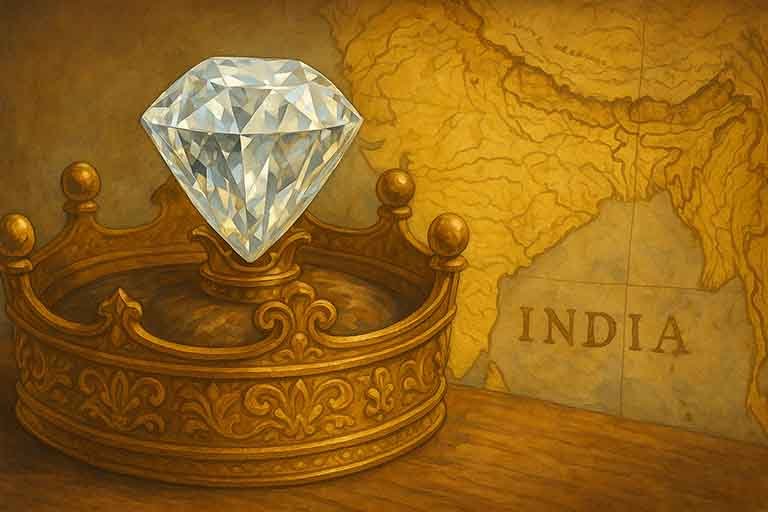Legend has it that he who owns the Koh-I-Noor (Kohinoor) diamond will own the world but will also know all its misfortunes. Only God or a woman can wear it with impunity. The story of this gemstone resembles a “Lord of the Rings” style drama, “one ring to rule them all” – powerful but cursed. Its journey also seems reminiscent of the Arkenstone of Durin’s Folk in The Hobbit, which made kings greedy and obsessed. The diamond’s curse is often cited as the reason behind the assassination of the Persian Emperor, the civil wars of the Durranis, the downfall of the Sikhs, or the mishaps in the British Royal Family. But is it truly a curse, or merely the course of history?
The Koh-I-Noor’s tale is one of poisoning, torture, blinding with the tip of a hot needle, molten lead poured into a prince’s crown to force him to reveal the diamond’s location, cholera on a ship, and even the accidental death of a prime minister. British historian William Dalrymple described it as “a perfectly scripted Game of Thrones-style epic. All the romance, all the blood, all the gore, all the bling.” Today, we explore the most infamous gem in the history of the world – the Koh-I-Noor.
Theories of Origin
Regarding its origin, the gem has two stories. Some historians believe it is mentioned in a Sanskrit text dated around 4000 BC, while others believe it was excavated from the alluvial plains of the Krishna delta in the Golconda region during the Kakatiya rule between 1100-1300 AD. The latter is the most widely accepted theory.
From Kakatiyas to Delhi Sultans
Once with the Kakatiyas, the gem changed hands when the Sultan of Delhi, Alauddin Khilji, sent his general Malik Kafur to raid the Warangal area, who acquired the gem from the loot. It then remained under the Delhi Sultanate, passed from one generation to the next until the last Sultans of Delhi, the Lodhis, faced the wrath of the Mughal invasion.
The Mughal Era
In the First Battle of Panipat, Babur emerged victorious and took possession of all the wealth of the Lodhis, including the Koh-I-Noor. Babur even described the worth of the gem as equal to half of the daily expenses of the global population, marking perhaps the first official record of the diamond’s grandiosity. Later, during Shah Jahan’s rule, the diamond was set in his Peacock Throne alongside other precious stones.
During Aurangzeb’s reign, French traveler Tavernier visited India. On being shown the gem by Aurangzeb, Tavernier made a graphical representation of it. A Venetian gem artist, Hortense Borgia, was later hired by Aurangzeb to make the gem more attractive. Borgia is said to have unfortunately overcut the Koh-I-Noor, reducing its weight from 793 carats to 186 carats. Most historians, however, consider this story a myth rather than fact.
Nadir Shah and the Plunder of Delhi
At the downfall of the Mughal Empire, Nadir Shah plundered Delhi multiple times, looting the Peacock Throne. Initially unaware of the Koh-I-Noor, Nadir Shah learned from one of Muhammad Shah Rangeela’s nobles that the Mughal emperor hid the diamond in his turban. In a ceremonial gesture, Nadir Shah tricked Rangeela into exchanging turbans, thus acquiring the Koh-I-Noor. Overwhelmed by its luster, Nadir Shah uttered “Koh-I-Noor,” meaning “Mountain of Light” in Persian (Koh meaning mountain, Noor meaning light). According to Persian sources, the Koh-I-Noor, along with the Timur Ruby, was part of the Peacock Throne. After the sack of Delhi, the throne and its gems were displayed in Herat, Iran.
From Persia to the Durranis
After Nadir Shah’s assassination, his first lady gifted the diamond to Ahmad Shah Abdali in return for protecting the honor of the harem. Abdali wore it in an armband and took it to Kandahar, where it remained for 70 years. The Koh-I-Noor passed through many hands during this time – at one point, a mullah in Kabul even used it as a paperweight. Eventually, Shah Shuja, Ahmad Shah’s grandson, took possession of the diamond. Deposed and banished, Shah Shuja was later captured in Kashmir. His wife broke a treaty with Raja Ranjit Singh, who was promised the Koh-I-Noor in exchange for rescuing Shah Shuja.
The Sikh Empire and British Conquest
The Koh-I-Noor remained under the rulers of Punjab for the next 36 years. During this time, the Sikh Empire achieved glory, but Raja Ranjit Singh and his three sons perished. A ten-year-old Duleep Singh, with Rani Jindan as regent, was forced to surrender the Koh-I-Noor after the Second Anglo-Sikh War. Lord Dalhousie shipped it from Bombay to England. On its journey to the British Isles, the curse seemed to strike again: a disease spread on the ship, the queen was attacked in England, and a prime minister died in an accident. All suspicions pointed to the Koh-I-Noor.
Read more: The Advent of Europeans in India
British Possession and Controversy
In 1850, the diamond was presented to Queen Victoria in a special ceremony, where she acclaimed it as a “Proud Trophy.” Her husband, King Albert, had it remodelled to make it wearable, reducing its weight further to approximately 105 carats. Since then, it has remained in British possession and is currently kept in the Jewel House in London as British Imperial property. For colonialists, the diamond symbolises the conquest of India; for some Indians, it represents colonial looting. The governments of India, Pakistan, and even a Taliban spokesperson have claimed ownership of the Koh-i-Noor.
A Contested Legacy
The Koh-I-Noor is not the only contested artefact. Former UK Prime Minister David Cameron once remarked that returning such artefacts would leave the British Museum empty. The diamond’s value has never been officially estimated, as it was never openly sold. Throughout history, it was either gifted, stolen, cheated, or looted. However, when Nadir Shah took it to Persia, he described its worth: “If a strong man were to throw four stones, one north, one south, one east, and one west, and a fifth stone up into the air, and if the space between these were to be filled with gold, all would equal the value of Koh-I-Noor.”
The Curse of the Koh-I-Noor
Some wonder why a famous British magazine called such a worthy gem the “Mountain of Darkness.” A Hindu text reportedly mentions that whosoever owns the gem is doomed to fail, and only a god or a woman can carry it. The British Royal Family, wary of the curse, has not had a male monarch wear it since Queen Victoria’s death in 1901. Richard Kurin, author of Hope Diamond, suggests the diamond is cursed because of the violent means used to acquire it throughout history. He adds, “When the powerful take things from the less powerful, the powerless don’t have much to do except curse the powerful.”








